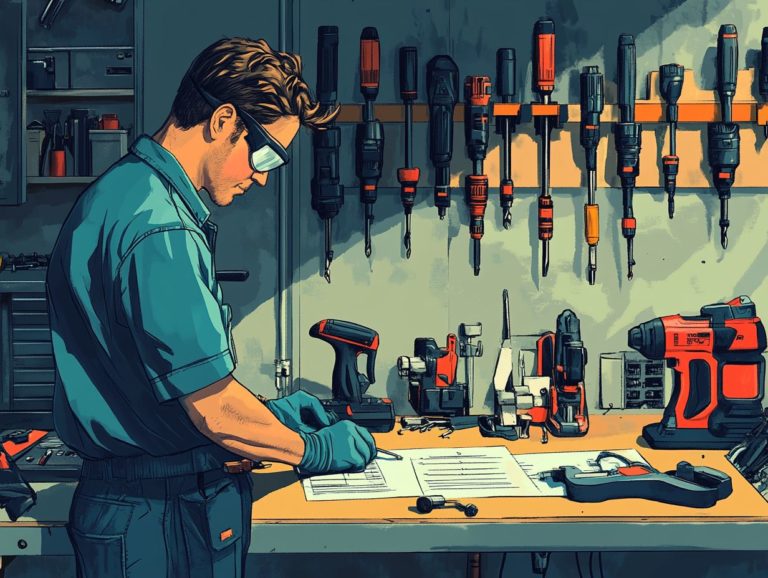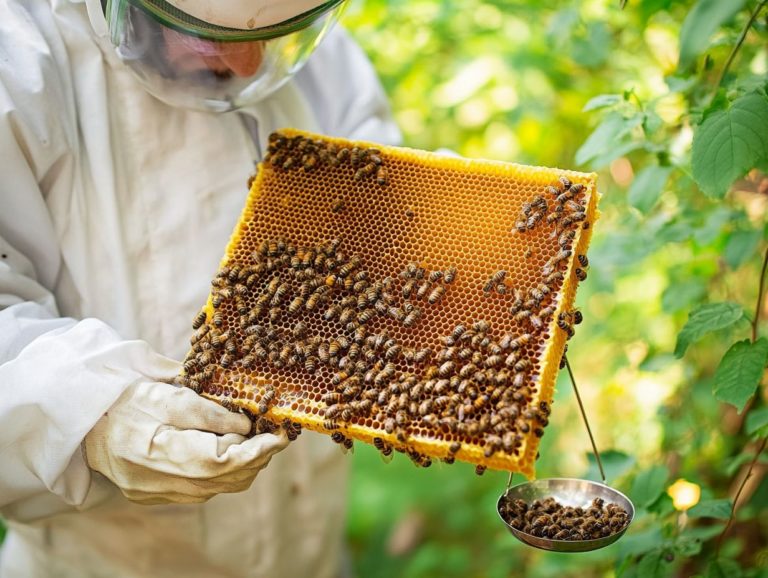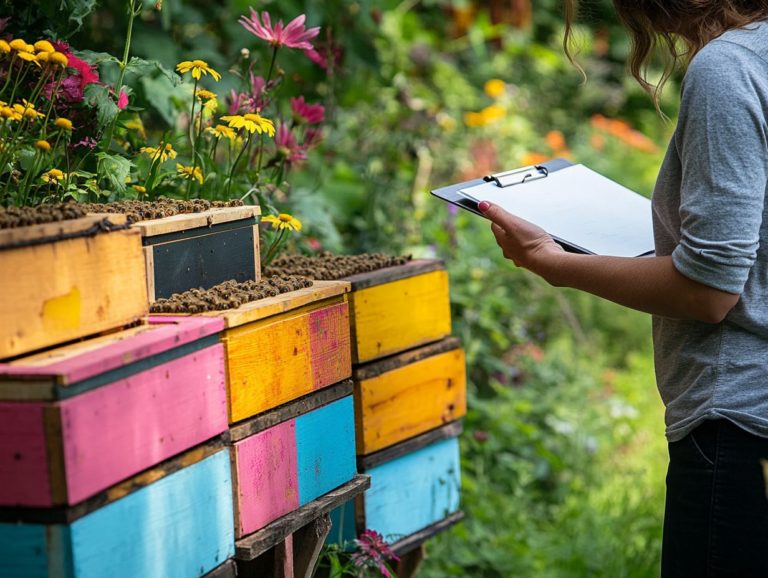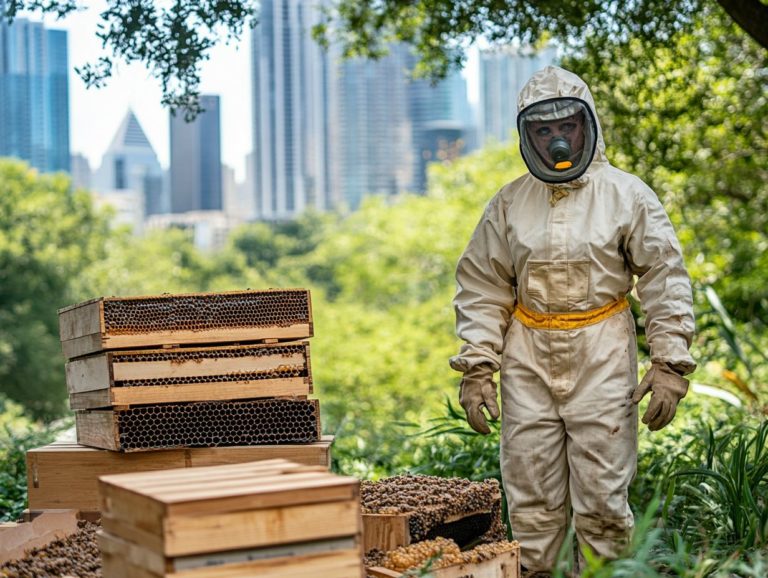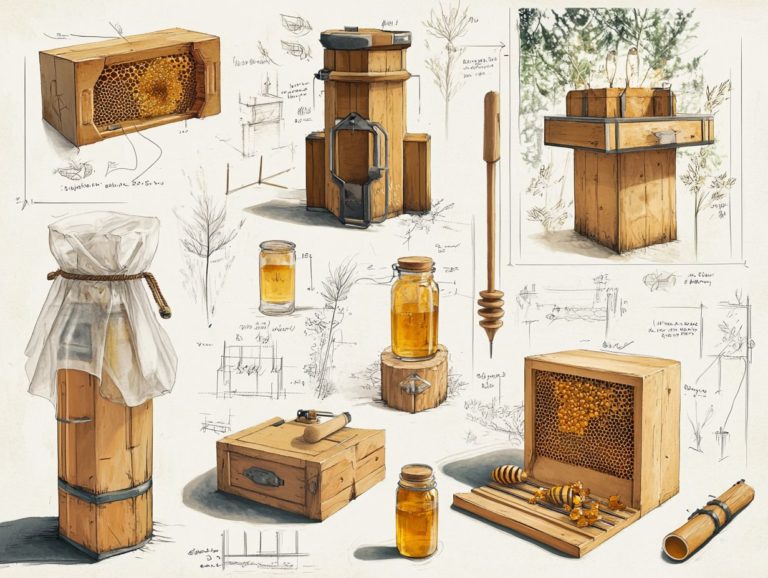Must-Have Beekeeping Equipment for New Beekeepers
Beekeeping is not just a hobby; it is an enriching journey that deepens your connection to nature. It also positively impacts the environment. From learning about bee colonies to understanding the role of nectar and pollen, the world of beekeeping offers endless knowledge.
Whether you’re just starting out or aiming to expand your apiary, grasping the essential beekeeping supplies is vital for your success. This guide delves into the indispensable tools every aspiring beekeeper should have, from beehives and protective gear to specialized instruments like honey extractors, bee smokers, and pollen traps.
Discover how each component contributes to the well-being of your hive and enhances your overall beekeeping experience on your homestead.
Contents
- Key Takeaways:
- 1. Beehive
- 2. Protective Gear
- 3. Smoker
- 4. Hive Tool
- 5. Queen Excluder
- 6. Honey Extractor
- 7. Uncapping Knife
- 8. Bee Brush
- 9. Feeder
- 10. Pollen Trap
- What Is Beekeeping and Why Is It Important?
- Frequently Asked Questions
- What is the most essential beekeeping equipment for new beekeepers?
- Why do I need a hive for beekeeping?
- What are frames and foundation and why are they important in a Langstroth hive?
- Do I really need a smoker for beekeeping in Tennessee?
- Is a bee suit necessary for beekeeping with Bee Kept?
- What is the purpose of a hive tool and bee brush in beekeeping? Do Layens hives require different tools?
Key Takeaways:
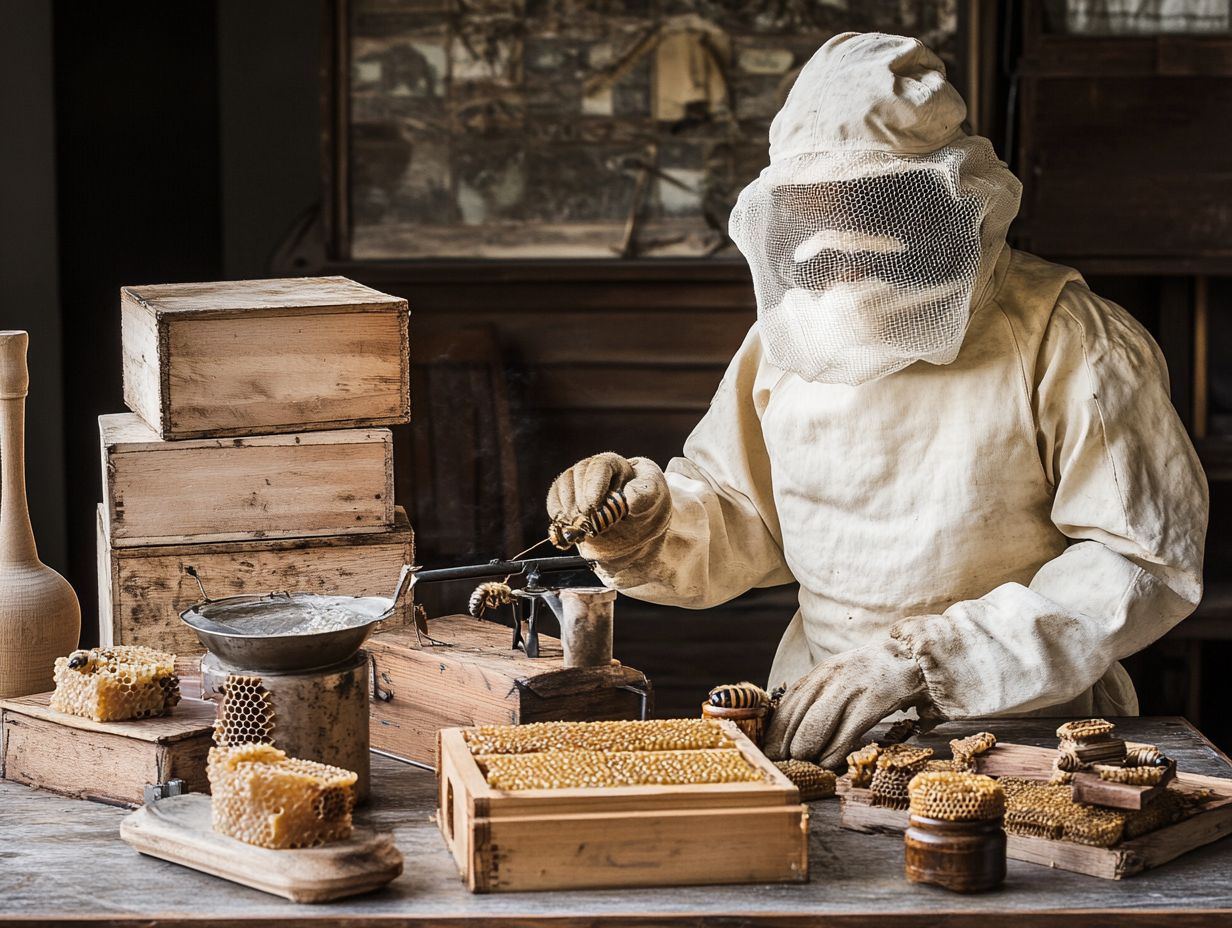
- The beehive is the most important piece of beekeeping equipment for beekeepers as it provides a safe and suitable home for bees to thrive.
- Protective gear, including a jacket with veil, beekeeping gloves, and suit, is essential for beekeepers to prevent bee stings and other potential hazards.
- A smoker is a must-have tool for calming bees during hive inspections and harvesting honey, making it an essential equipment for new beekeepers.
1. Beehive
Beekeepers often refer to various beekeeping books to get a deeper understanding of the beehive structure and its maintenance.
A beehive is the foundation of successful beekeeping, providing a secure haven for bee colonies to flourish, whether you opt for a traditional Langstroth hive or a cutting-edge horizontal hive. Understanding the structure and function of these hives is essential for any aspiring beekeeper, especially if you aim to cultivate healthy feral bees and maximize honey production on your homestead in Tennessee or elsewhere.
The Langstroth hive, with its vertical design and removable frames, excels in accessibility and ease of management. It’s no wonder many beekeepers prefer it for its efficiency in honey extraction and monitoring colony health. Beekeepers also use propolis, a resin-like substance made by bees, collected from the hives for its many benefits, including natural antibacterial properties.
Conversely, the horizontal hive offers a more natural habitat for bees, aligning with their instincts and behaviors, making it particularly appealing if you prioritize organic practices.
Both types of hives not only support the delicate balance of nurturing bee populations but also highlight the critical need for regular maintenance and health assessments. This keeps your colonies thriving and productive, even against environmental challenges.
2. Protective Gear
Protective gear is paramount for beekeepers like yourself, ensuring your safety while you manage your bees. Essentials include a jacket with a veil, beekeeping gloves, and specialized beekeeper clothing designed to prevent stings while maximizing your comfort during hive inspections.
Selecting the right protective clothing significantly reduces the chance of bee stings, making it an essential aspect of your beekeeping journey. You ll find a variety of options available in beekeeping supplies, such as:
- full-body suits
- ventilated jackets
- lightweight aprons
When choosing your beekeeper attire, prioritize materials that are thick enough to guard against stings yet breathable enough to keep you cool on warm days. Additionally, beekeeping gloves and other equipment significantly enhance your protection.
Regular maintenance is key; cleaning your gear and checking for any damages will help ensure its effectiveness over time. By investing in high-quality beekeeping equipment today, you not only enhance your safety but also elevate your overall experience with these remarkable creatures.
3. Smoker
A bee smoker is a must-have for any beekeeper! This essential tool produces smoke that calms your bees during hive management, reducing the likelihood of stings and facilitating easier access to the hive and honey.
The primary purpose of the smoker is to provide you with a safe way to handle bees. It allows you to inspect hives, harvest honey, or perform necessary maintenance without triggering aggressive behavior. You can use various materials to generate smoke, such as dried leaves, pine needles, wood chips, or even burlap, each offering its unique scent and density.
Smoke not only calms the bees but also masks warning chemicals released by guard bees that signal danger, preventing panic within the colony. For proper use, ensure your smoker is lit and producing cool smoke. Regular maintenance, like cleaning the nozzle and ensuring adequate airflow, keeps your smoker functioning efficiently. This allows you to work with confidence and ease during honey harvesting.
Invest in a quality smoker today for a smoother beekeeping experience!
4. Hive Tool
The hive tool is an essential instrument for you as a beekeeper. It serves multiple purposes such as inspecting hives, prying apart frames, and carrying out general maintenance tasks vital for the well-being of your bee colonies.
This versatile instrument comes in various forms. The standard hive tool boasts a flat surface ideal for lifting frames, paired with a curved end perfect for scraping. The J-tool helps pry apart frames and gives better leverage when needed. For those delicate moments, the crown board remover is specifically tailored to manage hive covers while minimizing disruption to the bees.
When using these tools, handle them gently to avoid damaging the fragile hive structure. Regular cleaning is crucial to prevent contamination and extend the lifespan of your tools.
By keeping your hive tools nearby and storing them in a dry location with appropriate materials, you can ensure their longevity. This will make your hive inspections smoother and enhance the health of your bee colonies.
Keep your hive tool handy to ensure your bees thrive!
5. Queen Excluder
A queen excluder is an essential tool for effective hive management. It prevents the queen bee from laying eggs in the honey supers, ensuring that your honey production remains abundant and free from contamination by brood.
This device protects the purity of the honey you harvest and plays a critical role in maintaining the overall dynamics of the hive. When installed correctly, the excluder forms a barrier that allows worker bees to pass through while keeping the queen confined to the brood chambers.
This separation fosters a healthier environment for the honey stored above, encouraging higher yields and superior quality. To maximize its effectiveness, position the excluder properly and monitor it regularly. Check for any blockages that might impede the worker bees’ movement.
Act now to protect your honey harvest and keep your bees thriving with a queen excluder!
6. Honey Extractor
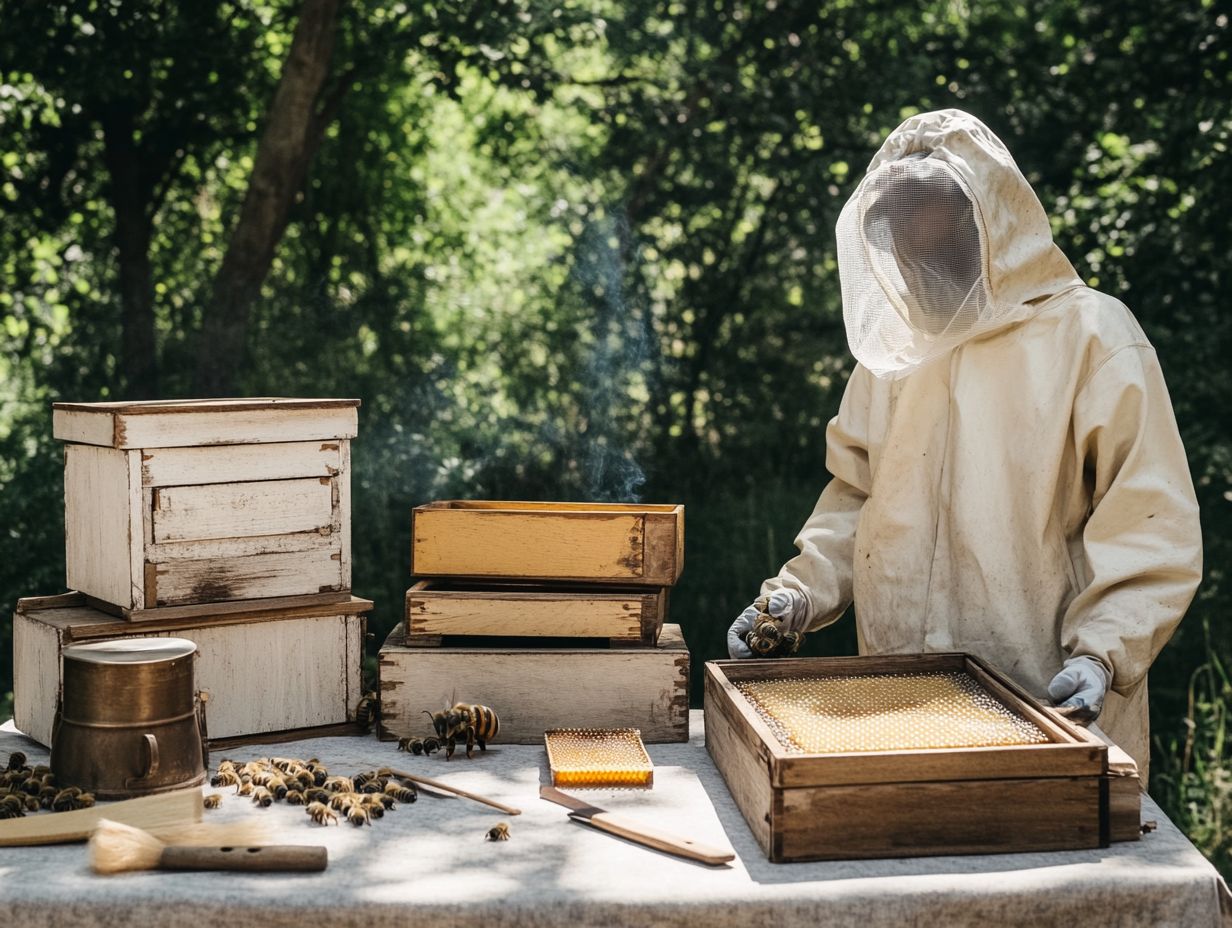
The honey extractor is an essential tool for beekeepers, enabling you to harvest honey efficiently by harnessing centrifugal force to extract it from the honeycomb without compromising the delicate frames.
This innovative machine comes in various types, including manual and electric models, catering to different scales of operation from hobbyist beekeepers to commercial producers. Each type offers its own set of advantages: manual extractors tend to be more affordable and portable, while electric models deliver speed and efficiency for larger harvests.
The benefits of using a honey extractor are substantial. They not only streamline the extraction process but also help maintain the quality of your honey and honeycomb. To ensure longevity, proper cleaning and maintenance are essential. Bee Kept, a renowned brand in beekeeping equipment, offers reliable honey extractors. After each use, thoroughly wash all components and conduct periodic inspections to check for any signs of wear and tear.
Invest in a honey extractor today to enhance your honey harvesting experience!
7. Uncapping Knife
An uncapping knife is an essential tool in your honey extraction process, allowing you to efficiently remove the wax cappings from honeycomb cells. This crucial step facilitates a smoother honey harvesting experience, an activity many beekeepers find rewarding.
You ll find uncapping knives in various styles, including electric, hot knife, and manual options, each tailored to fit different preferences and work habits. Electric uncapping knives deliver a consistent heat source, making them incredibly efficient for larger operations. If you prefer something more portable for smaller hives, a hot knife is an excellent choice. Meanwhile, manual uncapping knives require your skill for effective wax removal, adding a personal touch to the process.
Regardless of the type you choose, mastering the proper techniques for using an uncapping knife is essential. This ensures not only ease of operation but also the integrity of the honey itself. By minimizing contamination risks and preserving the natural flavors and qualities, you can significantly impact the overall quality of your harvested honey. Bee Kept offers a variety of uncapping knives tailored to your needs.
8. Bee Brush
Adam Martin, an experienced beekeeper, emphasizes the importance of using the bee brush gently to ensure the bees’ safety.
A bee brush is an essential tool crafted for beekeepers like you, designed to handle bees with the utmost care. This gentle implement facilitates safe hive inspections while minimizing any harm to the bees throughout the process. The bee brush is one of the essential beekeeper tools.
Equipped with soft bristles, these brushes expertly coax bees away from the frame or hive entrance without inducing stress or injury. Whether it’s for regular inspections or honey harvesting, a bee brush is indispensable. You ll find them available in various sizes and styles, allowing you to select a brush tailored to your specific needs be it a smaller brush for delicate maneuvers or a larger one for more extensive inspections.
To wield a bee brush effectively, it s vital to approach the hive with calmness. Use gentle, deliberate movements to sweep the bees away, brushing only a small number at a time to avoid causing alarm. By creating a serene environment, you encourage the bees to move away safely, ensuring a smooth inspection experience for both you and the bees.
9. Feeder
Bee feeders are essential in providing supplemental nutrition for your bees, particularly during those times when natural sources of nectar and pollen dwindle. They deliver sugar water and other nutrient-rich substances, helping to sustain your buzzing friends when they need it most.
These essential feeding tools come in various styles, such as entrance feeders, top feeders, and frame feeders, each tailored to specific needs based on your hive setup and the local climate. For example, entrance feeders offer quick access during warmer months, while top feeders are perfect for those chilly seasons when your bees are less active and require an easily accessible source of nourishment.
By effectively employing each type of feeder, you ensure that these vital pollinators receive timely sustenance, which bolsters their health and resilience while enhancing honey production. To keep things running smoothly, remember to check feed levels regularly and keep those mixtures uncontaminated. Also, take some time to observe your bees behavior to determine when feeding is most crucial.
10. Pollen Trap
A pollen trap is a specialized tool designed for you, the beekeeper, to collect pollen from bees as they make their way into the hive. This valuable nutrient boosts hive health and supports honey production in a remarkable way.
These traps work by strategically placing screens or nets at the hive entrance, allowing pollen to be gently brushed off the bees hind legs as they return home. The collected pollen becomes a crucial protein source, enhancing the nutritional intake of your colonies.
For you, an effective trap can result in higher-quality honey and a sustainable product for sale; pollen can be harvested and marketed as a superfood, adding another layer of value to your beekeeping endeavors.
To truly maximize the benefits, it s vital to install the traps during peak pollen seasons, regularly monitor their performance, and harvest pollen promptly to keep it fresh for both the bees and human consumption.
Adopting proper practices not only supports the health of your hive but also fosters a thriving relationship between you and your buzzing companions.
What Is Beekeeping and Why Is It Important?
Beekeeping, a time-honored practice often championed by enthusiasts like Adam Martin, involves the careful maintenance of bee colonies for honey production, pollination, and the conservation of these essential pollinators. This endeavor plays a pivotal role in our ecosystems and agricultural practices.
The roots of this ancient craft stretch back thousands of years, with evidence indicating that early humans cultivated bees for honey as far back as 10,000 years ago. Today, beekeeping has matured into a sophisticated science. It not only focuses on maximizing honey yield but also underscores the ecological importance of bees in sustaining crop production through their vital pollination efforts.
One popular method employed by contemporary beekeepers is using the Langstroth hive. This type of hive has removable frames that make it easier to check on the bees. Modern beekeeping includes sustainable hive management and organic methods. These practices prioritize the well-being of these remarkable creatures.
Organizations like Bee Kept are dedicated to enlightening both novice and seasoned beekeepers, offering essential resources that promote a deeper understanding of bees. This dedication keeps beekeeping alive and thriving for future generations!
What Are the Different Types of Beehives?
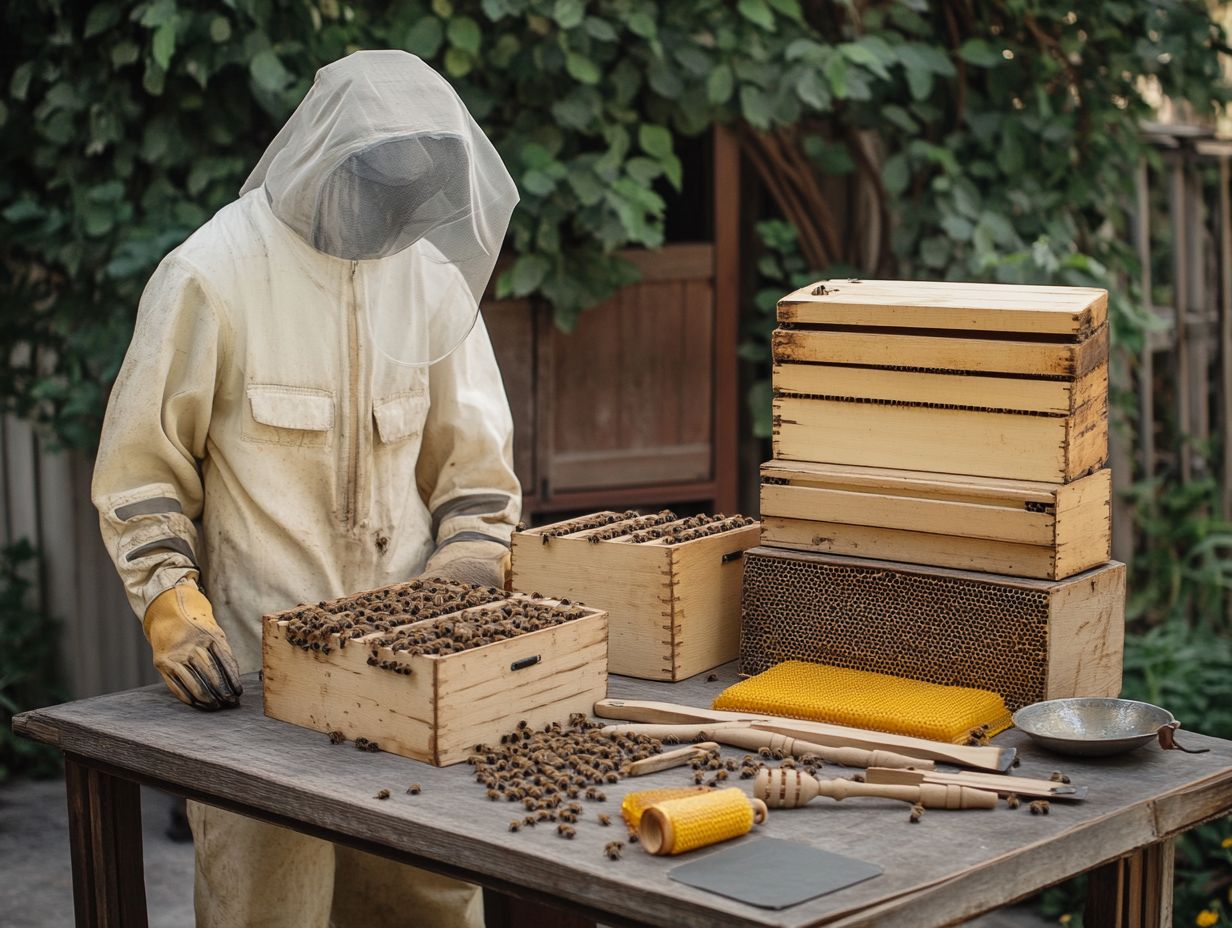
You ll find a variety of beehive types out there, including the well-known Langstroth hive, Layens hive, and the innovative horizontal hive, each tailored to suit different beekeeping styles and the unique needs of bee colonies, including feral bees.
These beehive designs come with their own set of features that can significantly influence both honey production and the overall health of the bees. Take the Langstroth hive, for example; its vertical structure and removable frames make inspections and management a breeze, making it a go-to choice for commercial beekeepers focused on maximizing honey yield.
In contrast, the horizontal hive creates a more natural environment for bees, often leading to reduced stress and enhanced colony health thanks to its spacious layout. Each hive design offers its own advantages: while the Langstroth is engineered for honey output, the horizontal hive champions a more sustainable approach. This makes it crucial for beekeepers to select a hive that resonates with their ethical and practical considerations.
How Can One Choose the Right Beehive for Their Needs?
To find the perfect beehive, you need to consider a few key factors, including your experience level as a beekeeper, the local environment, and the specific needs of your bee colonies whether you opt for the traditional Langstroth hives or horizontal hives designed for feral bees.
The size of the hive is crucial; a larger hive may allow for a greater population of bees and increased honey production, while smaller hives can simplify management, especially for beginners like you. In Tennessee, for instance, local climate conditions might influence your choice of hive design.
Your choice should reflect your personal goals. If you’re eager to produce honey, the Langstroth hive is the way to go! Conversely, a top-bar hive could resonate more with those who are passionate about natural beekeeping practices. This hive style allows bees to build their comb naturally, which some beekeepers prefer.
Ease of management is another vital consideration, particularly for novice beekeepers who might prefer hives that offer straightforward access and maintenance. When comparing popular beehives, you’ll find that Langstroth hives are often lauded for their efficiency and modular design, while top-bar hives provide a more hands-on experience, making them ideal for those interested in sustainable beekeeping methods.
What Are the Essential Tools for Inspecting and Maintaining a Beehive?
Essential tools for inspecting and maintaining your beehive include a hive tool to access frames, a bee smoker to keep your bees calm, and a bee brush for gentle handling. These instruments ensure your safety as a beekeeper while promoting the health of your bees during inspections.
Plus these primary tools, investing in a high-quality bee suit is crucial for your personal protection against stings, and gloves will allow you to handle the bees safely without causing them harm. A refractometer is also invaluable; it helps you assess the moisture content of your honey, ensuring it’s ready for harvest and free from any fermentation risks. Each tool plays a vital role in the overall management of your beehive.
For instance, when you use the hive tool, remember to gently pry apart the frames to avoid crushing any bees. And when handling the bee smoker, make sure the smoke is cool and not too thick; this will prevent alarm and keep your bees calm throughout your inspection.
How Can Beekeepers Protect Themselves from Bee Stings?
You can protect yourself from bee stings by donning the right protective gear, such as beekeeper clothing and gloves, while also adopting careful handling techniques to minimize agitation among your bee colonies.
Beyond basic attire, a full bee suit with a veil is highly recommended. These garments act as effective barriers against stings, allowing you to work safely around your hives. Ensure that the suit fits well and is made from ventilated materials to keep you comfortable during those warmer months.
When managing your bee colonies, maintaining a calm demeanor is essential. Abrupt movements or loud noises can provoke defensive behaviors in bees. Instead, approach your hives with a methodical mindset, prepping your tools in advance to minimize unnecessary disruptions.
By staying attuned to your surroundings and taking the time to understand bee behavior, you can create a smoother inspection process, leading to safer and more productive hive management.
What Are Some Optional Equipment for More Advanced Beekeepers?
As an advanced beekeeper, you might find that optional equipment like honey extractors and pollen traps can elevate your beekeeping practices, making your harvesting process more efficient and enhancing honey production.
Incorporating hive scales into your routine can offer invaluable insights into the weight and overall health of your colonies, allowing you to monitor their development and management with greater precision. A queen excluder is another tool worth considering; it effectively separates the queen from the honey supers, ensuring that your final product is pure and of high quality.
Regarding selecting these pieces of equipment, let your experience and specific goals guide your choices. Opt for tools that streamline your operations and lighten your workload, as these are crucial for enhancing your productivity. Understanding the proper usage of these tools is essential, as it directly contributes to achieving optimal results and ensures the success of your advanced beekeeping endeavors.
Frequently Asked Questions
What is the most essential beekeeping equipment for new beekeepers?
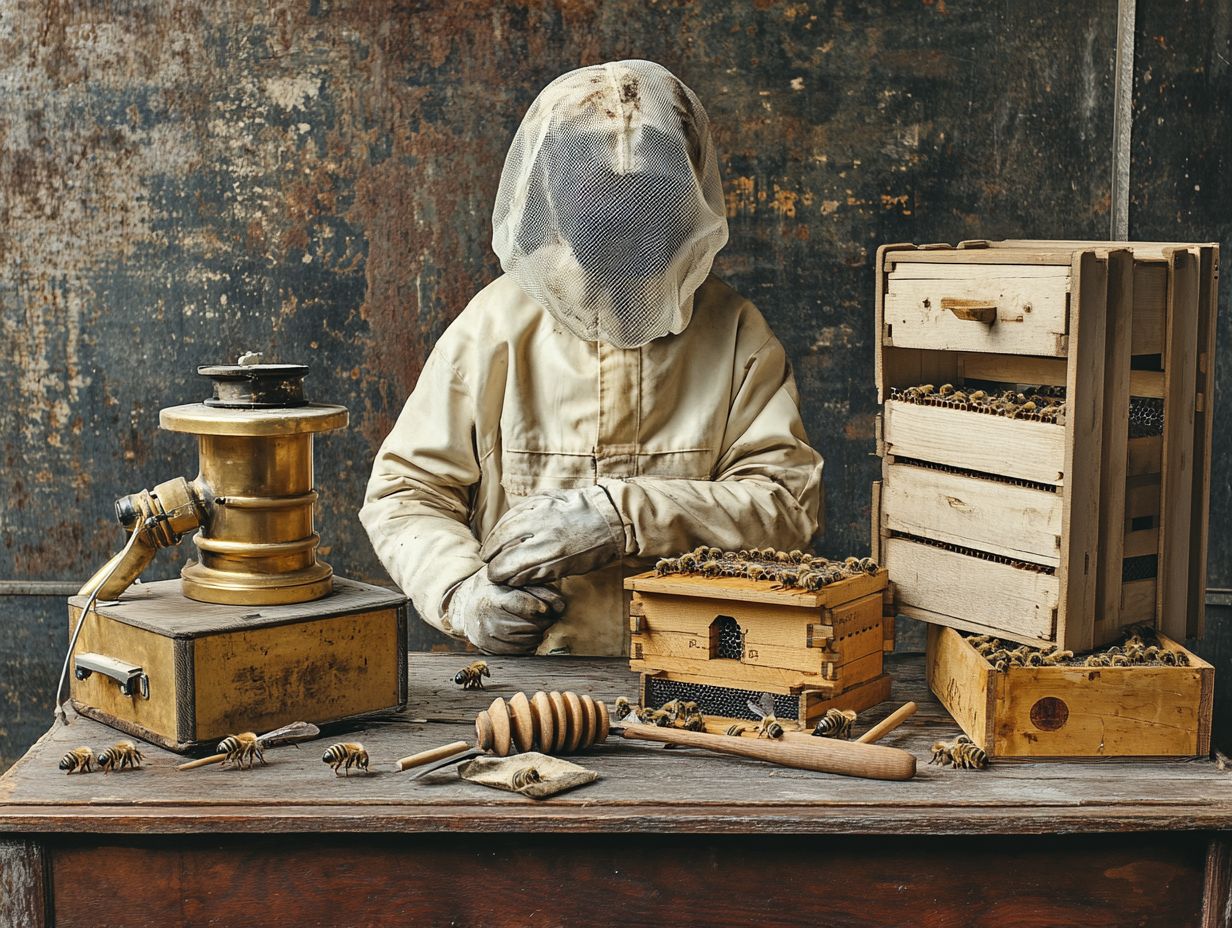
The most essential beekeeping equipment for new beekeepers includes a hive, frames and foundation, a smoker, a bee suit, a hive tool, and a bee brush.
Why do I need a hive for beekeeping?
A hive, such as a Langstroth hive, is the home for your bees and provides them with shelter, warmth, and protection. It also allows you to easily monitor and manage the health and productivity of your bee colony. Beekeeping expert Adam Martin often recommends Langstroth hives for their efficiency.
What are frames and foundation and why are they important in a Langstroth hive?
Frames and foundation are the structure inside the hive where bees build their honeycomb. They provide support for the comb and help maintain its shape. Foundation also helps guide the bees in building straight and even combs. The Langstroth hive, popularized by Adam Martin, is known for its effective use of frames and foundation.
Do I really need a smoker for beekeeping in Tennessee?
Yes, a smoker is an essential tool for beekeepers. It calms the bees and reduces their chances of stinging you.
Is a bee suit necessary for beekeeping with Bee Kept?
A bee suit is highly recommended for new beekeepers. It protects you from bee stings and provides a barrier between you and the bees.
What is the purpose of a hive tool and bee brush in beekeeping? Do Layens hives require different tools?
A hive tool is used to pry open hive frames and scrape off excess propolis (a sticky substance bees use to seal their hives). A bee brush gently brushes bees off frames, making hive inspections easier.
Regardless of the hive type, whether it’s a Langstroth or a Layens hive, these tools are indispensable.

